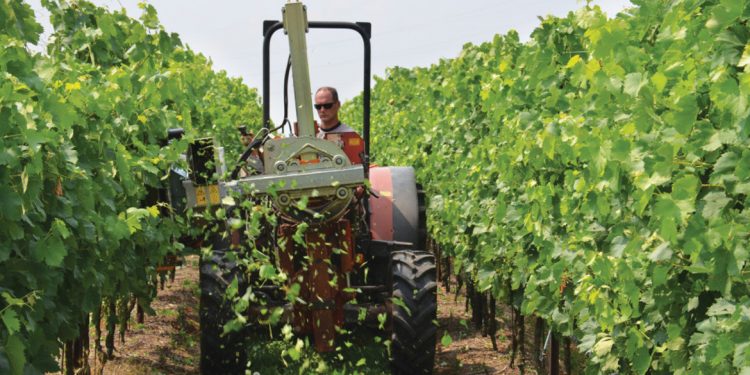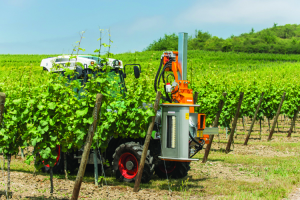
Canopy thinning is good for Sangiovese

By Riccardo Oldani
Delilah cut Samson’s hair to deprive him of his superhuman strength. For Sangiovese, though, a targeted reduction of the foliage carried out at the right time produces the opposite result: a stronger and hardier plant. A research team from the University of Bologna, headed by professor Cesare Intrieri, has shown (with a large scale experiment from 2010 to 2014 and an ongoing study that began beforehand) that careful management of the canopy, i.e. the foliage, of Sangiovese vines can be advantageous not only for the quality of the product but also from a financial point of view.
Canopy thinning improves grape quality
If this is done carefully early on in the year, savings of up to 80% can be made on vineyard management costs necessary for controlling the yield per hectare. Whereas a second, later leaf thinning improves grape quality, normalizing the sugar/acidity ratio and increasing colour and aroma synthesis in the berries. Intrieri presented his work at the eighth Symposium of the Institute of Masters of Wine in Florence last May. Now he explains the main points to Civiltà del bere.
High productivity and early ripening
“The Sangiovese variety,” the researcher explains, “has essentially two critical issues. The first is the high productivity of basal buds produced by the spurred cordon, the most common training system, which translates into a high number of very compact bunches. And this is not in line with some of the production regulations, like those for Chianti or Brunello di Montalcino, which impose a yield of no more than 70-80 quintals per hectare. To keep this under control, wineries usually manually thin bunches, which entails manual labour and high costs. The second problem is linked to the fact that the increase in temperature during the year speeds up ripening. This means higher sugar levels in grapes and a higher alcohol content, which should not exceed 13.5-14% vol. in an ideal wine.
How to put it right?
To avoid this happening, there is a tendency to bring forward the date of the harvest, which is more and more often during the third week in September for Sangiovese, and sometimes even earlier. However, this stops phenolic ripening completing, which is responsible for the colour and aromas that give the wine its characteristic notes, and produces grapes with too-low acidity, with a negative effect on the quality of the final product.”
Away with the leaves and the bunch is healthier
Intrieri and his staff have identified two innovative canopy management systems for successfully tackling the above-mentioned difficulties. For the first problem, they started with data on vine physiology and realized that eliminating the leaves nearest to the inflorescences, before the flowering stage, slowed down the synthesis of the sugar substances that nourish them and, consequently, reduced the number of flowers that develop into bunches. In order to test their theory, the researchers collaborated with Antinori and conducted tests in the vineyards at the Le Mortelle estate in the Tuscan Maremma. They removed about 30% of basal leaves from the spurred cordon, the ones nearest the inflorescences.
The final result
“This operation was done with mechanical leaf removers,” explains Intrieri, “in a short period of time, no more than 3 hours per hectare, and with an estimated saving of 70-80% with respect to the more usual manual bunch thinning.” What are the consequences? The research team observed the results over four years. “The final result is that we obtained fewer and looser bunches per plant, i.e. with more widely spaced berries than normal. We are talking about an average of 6.9 bunches per plant compared to 8, for a harvest of about 1.8 kg of grapes per vine compared to over 2.5 kg and a weight of 262 g for a single bunch compared to 318 g, with a consequent improvement in the sugar/acid ratio.
The advantages
But there are also other important advantages. The percentage of Botrytis attack went from 17.8% of surface area for sample vines treated traditionally, down to 6.3%. Furthermore, the berries were smaller, with a higher percentage of skin compared to pulp and a higher quantity of polyphenols and anthocyanins, which give colour and aromas to the wine.”
A targeted action delays the harvest
At the Tenuta Tignanello estate, Intrieri and his staff carried out experiments to see how to deal with the second problem, that of the ever-more frequent bringing forward of the harvest that prevents the full completion of phenolic ripening. “In the vine,” says Intrieri, “through photosynthesis, the leaves determine the production of sugars that go on to accumulate in the bunches. Slowing down this process enables us to delay the moment when the grapes reach the desired sugar levels and optimal concentration of anthocyanins and polyphenols.” Therefore, also in this case the idea is to eliminate some of the leaves, especially those with the most intense photosynthetic activity in the key grape ripening stage, veraison, i.e. the moment when the bunches start to gain colour.
The secret is…
The vine leaves have a limited capacity for photosynthesis over time, which begins to reduce after just 35-40 days. Afterwards they are replaced by younger ones that form in the apical zones of the growing shoots. “Therefore the secret,” concludes the professor “is to eliminate some of the apical leaves at veraison and especially when there is a concentration of sugar in the berries of about 15°Bx.” If leaf thinning is done at this precise stage of plant development, you obtain a delay in grape ripening of one or two weeks, which allows the harvest to be done in the first ten days of October, at a lower average temperature compared to September.
Not only Sangiovese
This is ideal for obtaining the right sugar level and complete phenolic ripening. “If, however, thinning is done when the concentration of solids is over 15°Bx you do not get the same favourable result.” The techniques developed by Cesare Intrieri and his team have proved to work with other grape varieties, too. Research continues. Both to identify which varieties respond best to targeted leaf thinning, and to verify whether both methods can be carried out on the same vines in the same year, in order to accumulate the expected results. Intrieri is sure they can.
From Italian Wine Chronicle 1/2015. Read for free the magazine
See also ...


The battle continues with the new Chianti Gran Selezione
On 11th November, the Chianti Wine Consortium announced Read more


Changes at the top in Genagricola and Santa Margherita
Big news in Genagricola and Santa Margherita Gruppo Read more


Pinot Grigio delle Venezie: the first national conference
The curtain will rise on the new appellation Read more


